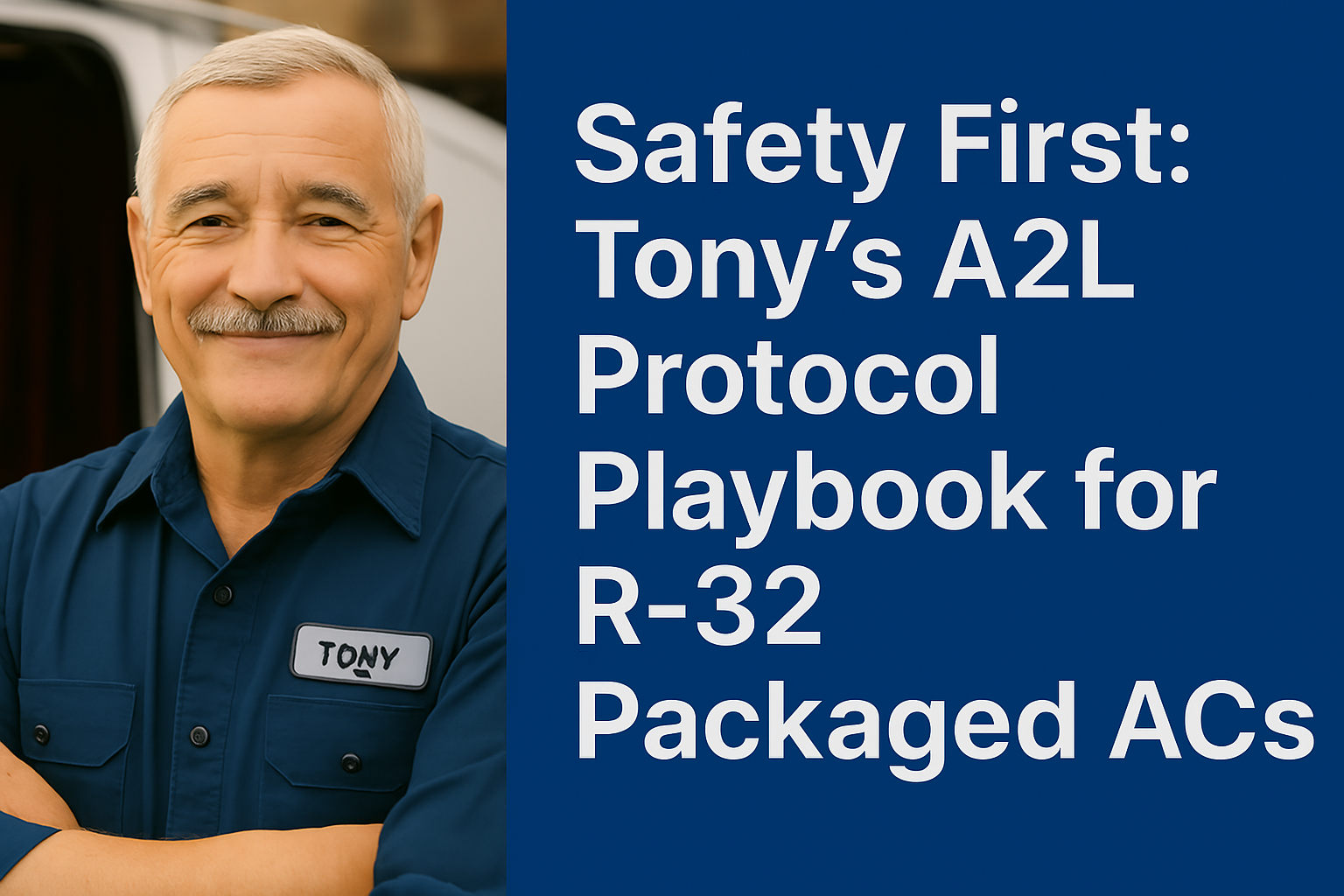🧰 Hey Friends!
Hey, Tony here. Let me be straight with you—if you're working with R-32 packaged ACs and you think the same old rules apply, you’re asking for trouble 💥. R-32 falls under the A2L classification, which means it’s mildly flammable, and that changes the game. I’ve seen guys torch their reputations (and almost their garages) because they didn’t respect the protocol.
This post isn’t theory—it’s what you need to actually stay safe, pass inspection, and sleep easy. I’m walking you through the tools, the prep, the codes, and what to do when something leaks.
So zip up that coverall and let’s get into it. 😤
1. 🔍 Know What You’re Dealing With – R-32 & the A2L Class
R-32 is what the industry calls a mildly flammable refrigerant, or A2L. It’s cleaner and more efficient than R-410A, but that bump in performance comes with new safety rules.
According to the UL 60335-2-40 safety standard, A2L systems must include:
-
Ignition-free components near the compressor
-
Ventilation features to reduce concentration buildup
-
Sensor-triggered airflow or alarms
-
Max charge limits based on room volume
ASHRAE backs this up in Standard 15—you’ve got to follow charge limits and equipment requirements to the letter, especially when installs are near occupied spaces.
2. 🏗️ Prep the Site Like a Pro
Here’s where most guys mess up. A lot of packaged ACs are rooftop or slab-mounted, so you might assume there’s nothing to worry about. Wrong.
You’ve still got to:
-
Ensure clearances to windows, doors, and ignition sources
-
Provide natural or mechanical ventilation if it’s near any confined structure
-
Avoid recessing units in enclosures without airflow
-
Use ASHRAE’s refrigerant concentration limit calculators to size your venting if you're going semi-enclosed
Trust me: a unit crammed in a walled-in nook with poor airflow is a ticking time bomb 💣.
3. 🧰 Don’t Show Up with Outdated Tools
This one should be obvious, but I’ve seen too many old-school techs try to MacGyver it. Not here. A2L-rated systems require A2L-rated tools.
You’ll need:
-
Manifold gauges with rated hoses and valves
-
Recovery cylinders clearly labeled for A2L use
-
Explosion-proof vacuums and nitrogen regulators
-
A leak detector rated specifically for A2Ls
Tool brands like Fieldpiece and Yellow Jacket have great options. And the EPA’s technician fact sheet lays out which recovery and service tools are acceptable.
Skip the right gear and you’re not just unsafe—you’re out of code.
4. ⚠️ Know How to Handle a Leak Before It Happens
When an R-32 leak hits, there’s a right way and a dead-wrong way to respond. This stuff isn’t R-22—you can’t just crack a window and hope for the best 😬.
Make sure you:
-
Evacuate people from the area immediately
-
Kill all electrical switches nearby
-
Ventilate using dedicated fans (not ceiling fans!)
-
Detect and repair the leak using certified methods
-
Perform a new vacuum and recharge only after full system safety is verified
UL and manufacturers recommend leak sensors on units with 4+ lbs of refrigerant. These trigger dilution fans if concentrations near 25% of the lower flammability limit (LFL)—and if you want the math, Texas Instruments explains how A2L sensors work.
5. 🚚 Storage, Transport, and Certification
Quick reminder: transporting or storing A2L refrigerant is regulated. You’ve gotta:
-
Store cylinders upright, secured, and in a ventilated area
-
Never leave them in a closed vehicle
-
Clearly label tanks and keep MSDS sheets handy
-
Only handle if you’ve got your EPA Section 608 cert
AHRI’s safe refrigerant handling guidelines are a must-read if you’re stocking R-32 in the shop or the truck.
No license? No touch. And don’t even think about reusing an old R-410A cylinder. That’s a hard fail ❌.
🛑 Final Checklist Before Charging
Here’s my go-to safety rundown on install day:
✅ Confirm unit and sensor placement
✅ Evacuate to below 500 microns
✅ Nitrogen pressure test at 300–500 psi
✅ Use A2L-rated scale and tools
✅ Check for leaks with an A2L detector
✅ Verify sensor alarms trigger at 25% LFL
✅ Ventilate if needed
✅ Fill out your log sheet 📋
Miss a step? You’re not done.
🧯 Wrap Up – R-32 Is Ready, If You Are
R-32 systems are leaner, greener, and cooler than what we used 10 years ago. But that edge in performance? It comes with a responsibility.
Don’t treat A2L protocols like some bureaucratic red tape. These rules keep you, your customer, and your install site out of the headlines. Follow the standards. Use the right gear. And educate the crew.
And if you're ready to work with the right equipment—units that meet the latest R-32 and A2L requirements—check out The Furnace Outlet’s R-32 packaged AC collection. These systems are built for performance and compliance from the start. 💪
Need to know more about line sets for your unit? Check out Keep It Tight: Tony’s Line-Set Playbook for R-32 Packaged ACs.
You handle the safety. Let the system handle the rest.
Catch you on the next install,
—Tony 🔧🔥







